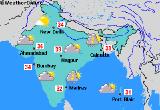Post Monsoon: This season starts, when monsoon after drenching all of India, begins to retreat. With the month of September, rainfall began to decrease and as we approach November, the monsoon is completely gone from major part of India.
Factors Affecting India's Climate
There are certain factors which affect the climate of India:
Latitude: The Tropic of Cancer passes through the middle of India and extends from Mizoram in the east and Rann of Kutch in the west; and considerably affects the climate of the country. To the south of the Tropic of Cancer lies the southern part of the country which belongs to the tropical area and to its north lies the northern half of India which belongs to the sub-tropical area. Therefore, India experiences both sub-tropical and tropical climates.
Altitude: In the north, India is bounded by mountains with an average height of 6,000 metres and in the south, has a vast coastline with maximum elevation of about 30 metres. The Himalayas act as a barrier against the cold winds from Central Asia. Therefore due to the altitude of these mountains, the Indian subcontinent experiences milder winters than Central Asia.
Monsoon Winds: The 'monsoon winds' is the most dominating factor influencing the climate of India. It is often called the monsoon climate. A reversal in the monsoon winds can bring a change in the season of the country, for instance the extreme summer season suddenly changing to the rainy or monsoon season. The entire country receives rainfall due to the south-west summer monsoons from the Bay of Bengal and Arabian Sea.
Western Disturbances and Tropical Cyclones: Large parts of peninsular India get influenced by the tropical cyclones which originate in the Arabian Sea and the Bay of Bengal. Most of the cyclones originate in the Bay of Bengal and influence the climatic conditions at the time of the south-west monsoon season. The western disturbances originate over the Mediterranean Sea and influence the weather conditions in the Western Himalayan region.
Climate Related Calamities
Climate related calamities are a great cause of loss to the life and property. Some of the natural disasters that have been experienced in the country are as follows:
Landslides and Floods: Floods are the most common natural disaster in India and are caused due to the inadequate capacity within the river banks to carry high flows which are brought down from the upper catchment because of the heavy rains. Almost the entire country is flood prone and the precipitation events like torrential rains and flash floods have become common in central India in the last few decades. But, the regions located in the Indo-Gangetic plains and northeast India are more prone to floods. Erratic, excess or untimely monsoon rains can kill thousands of people and also harm the agriculture of the country.
Droughts: Drought is a situation which arises due to the scarcity of water. In India, agriculture depends on the rains or the monsoon season as a source of water. But, the shortage or failure of water results in the below-average crop yields. Climatic factors such as high wind, high temperature and low humidity also add to the severity of drought in India. Andhra Pradesh, Rajasthan, Gujarat, Odisha, some parts of Maharashtra and Karnataka are some of the drought-prone areas in the country. India has witnessed many famines such as Bengal famine of 1770, 1876-77, 1899 and 1943 which took lives of millions of people.
Tropical Cyclones: These are the most devastating natural disasters which result in massive loss of life and property. In India, the lives of the coastal habitants are highly affected due to cyclones. The areas near the Bay of Bengal and Indian Ocean are the most cyclone-prone regions of the country. Coastal regions of Odisha, West Bengal, Tamil Nadu and Andhra Pradesh are more exposed to cyclones. During the time of cyclone, heavy rains, winds with high speed and storm surge are also experienced which also affect the lives of the people as it becomes difficult for them to get relief and supplies during this phenomenon. A super cyclone, Cyclone 05B that struck Odisha on 29 October 1999 is considered to be the deadliest cyclone in the country in the past few decades. It was considered equivalent to Category 5 hurricane.
Climatic regions in India
The various climatic regions of India are given below:
Climatic regions in India
The various climatic regions of India are given below:
| Name of climatic region | States or territories |
|---|
| Tropical Rainforest | Assam and parts of the Sahyadri Mountain Range |
| Tropical Savannah | Sahyadri Mountain Range and parts of Maharashtra |
| Tropical and subtropical steppe | Parts of Punjab and Gujarat |
| Tropical Desert | Most parts of Rajasthan |
| Moist subtropical with winter | Parts of Punjab, Assam, and Rajasthan |
| Mountain climate | Parts of Jammu and Kashmir, Himachal Pradesh, and Uttaranchal |
| Drought | Rajasthan, Gujarat, and Haryana |
| Tropical semi-arid steppe | Tamil Nadu, Maharashtra, and other parts of South India. |



